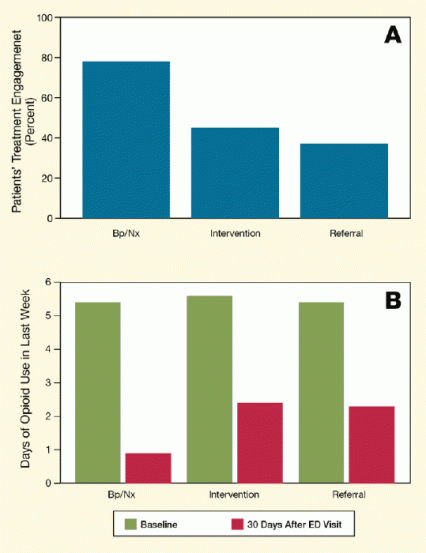
Emergency department (ED) visits present prime opportunities to identify people with opioid addiction and start them on the way to recovery. That’s one conclusion supported by a recent NIDA-supported study, which also points to onsite initiation of treatment with buprenorphine/naloxone (Bp/Nx) as the most effective strategy for capitalizing on these opportunities.
Drs. Gail D’Onofrio, David Fiellin, and colleagues at the Yale School of Medicine and School of Public Health screened 71,000 patients who presented for emergency care at a large urban hospital. Of 329 who met the researchers’ study criteria and were found to be addicted to opioids, one-third (34 percent) came to the ED seeking treatment for their opioid addiction, and another 8.8 percent were experiencing opioid overdoses. The rest were identified through screening after presenting with various other emergencies. Most (75.1 percent) used heroin, and the remainder reported misusing prescription opioids exclusively. Use or misuse of other addictive drugs was highly prevalent, including cigarettes (88 percent), cocaine (55 percent), marijuana (53 percent), and sedatives (47 percent).
The researchers assigned each patient addicted to opioids to one of three protocols:
- Referral for treatment via a handout with information on local treatment centers offering inpatient and outpatient care, and how to contact them
- A 10-to-15 minute motivational and informational discussion addressing drug use, addiction, and treatment, using the manualized Brief Negotiation Interview (BNI) modified for opioid users; plus active connection to local service providers, securing of insurance approval, and transportation arrangements
- The BNI and a sufficient take-home supply of Bp/Nx (preceded by an onsite initial dose of Bp/Nx for patients in withdrawal) to last until an initial scheduled appointment for office-based follow-up care within 3 days
 Figure. Participants Receiving Bp/Nx Treatment During an ED Visit Are More Engaged in Treatment and Report Lower Opioid Use After Their Visit A larger proportion of patients treated with Bp/Nx during their visit to the ED were enrolled in and receiving addiction treatment 30 days after the visit than participants receiving only a brief intervention or referral (see panel A). All of the study participants reduced their opioid use after their ED visits, but patients treated with Bp/Nx in the ED reduced their weekly opioid use more than patients in the brief intervention and referral groups (panel B).
Figure. Participants Receiving Bp/Nx Treatment During an ED Visit Are More Engaged in Treatment and Report Lower Opioid Use After Their Visit A larger proportion of patients treated with Bp/Nx during their visit to the ED were enrolled in and receiving addiction treatment 30 days after the visit than participants receiving only a brief intervention or referral (see panel A). All of the study participants reduced their opioid use after their ED visits, but patients treated with Bp/Nx in the ED reduced their weekly opioid use more than patients in the brief intervention and referral groups (panel B).
- Text description of graphic
-
The figure shows two bar graphs; the top graph (panel A) indicates the proportion of patients (in percent) involved in Bp/Nx treatment 30 days after an ED visit for patients addicted to opioids who were treated with Bp/Nx during the ED visit, received a brief intervention, or were given a referral to treatment. The bottom graph (panel B) shows the number of days of opioid use in the week preceding the ED visit for the three patient groups at baseline and 30 days after the ED admission. As shown in the top graph, 78 percent of the patients who received Bp/Nx at their ED visit were engaged in treatment for opioid addiction versus 45 percent and 37 percent in the brief intervention and referral groups, respectively. As shown in the bottom graph, patients in all three groups used opioids on more than 5 days in the week prior to the ED visit; opioid use dropped to less than 1 day for the patients who had received Bp/Nx during their ED visit and to just over 2 days for both the brief intervention and referral groups.
Data obtained from the addiction services to which the patients were referred found that 30 days after their ED visits, 78 percent of patients who were given Bp/Nx were engaged in addiction treatment, compared with 45 percent of those in the referral and brief intervention group, and 37 percent in the referral-only group (see Figure). The average number of days per week of self-reported opioid use, which was 5.4 in all groups at the time of their ED visit, had fallen to 0.9 in the Bp/Nx group, 2.4 in the interview plus referral group, and 2.3 in the referral-only group. Although there were no statistically significant between-group differences in the percentages of patients submitting opioid-negative urine tests (which ranged from 42.9 to 57.2 percent), the researchers attribute this to the highly sensitive urine assays not reflecting frequency or intensity of use, rather than to inaccurate self-reports.
Among the patients who were engaged in treatment at follow-up, fewer of those who had initiated Bp/Nx in the ED were enrolled in costly inpatient care (11 percent versus 35 to 37 percent in the other groups). Patients in all three groups exhibited similar reductions of about one-third in behaviors that increase the risk for contracting or transmitting HIV.
Dr. D’Onofrio and colleagues believe that expanding ED-initiated Bp/Nx, with community follow-up, is a promising approach to increase access to treatment for opioid addiction. They note, however, that because these results were obtained in one institution, further studies are required to confirm that screening, administering a brief motivational intervention, and immediately initiating Bp/Nx treatment can be implemented successfully at other sites.
This study was supported by NIH grant DA025991.
Source:
D’Onofrio, G.; O’Connor, P.G.; Pantalon, M.V. et al. Emergency department-initiated buprenorphine/naloxone treatment for opioid dependence: A randomized clinical trial. The Journal of the American Medical Association 313(16):1636-1644, 2015. Full text
